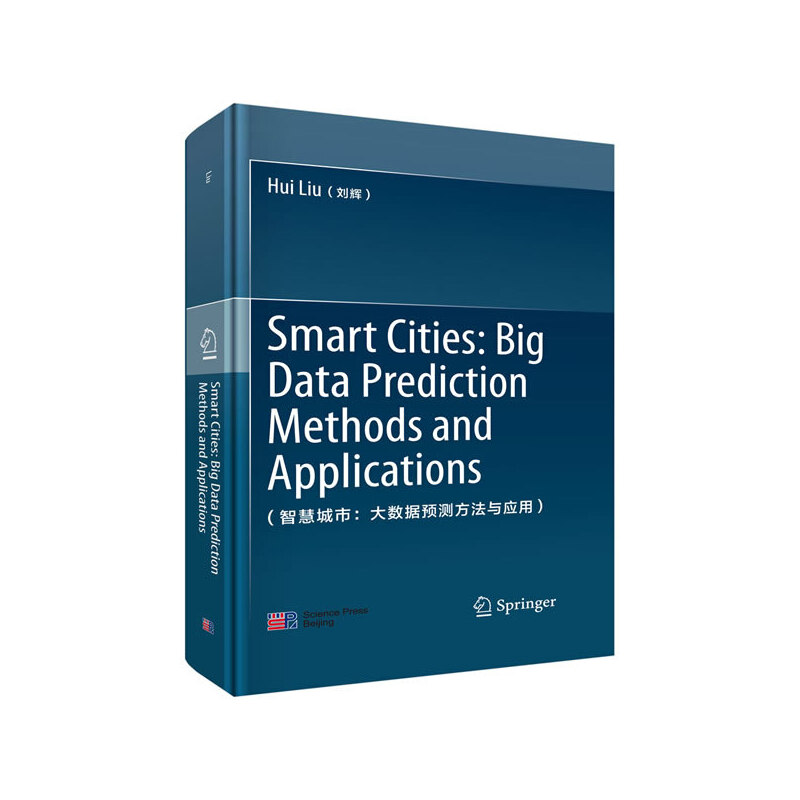
包邮智慧城市:大数据预测方法与应用:big data prediction methods and applications
1星价
¥148.5
(7.5折)
2星价¥148.5
定价¥198.0

暂无评论
图文详情
- ISBN:9787030631947
- 装帧:圆脊精装
- 册数:暂无
- 重量:暂无
- 开本:25cm
- 页数:31,314页
- 出版时间:2020-01-01
- 条形码:9787030631947 ; 978-7-03-063194-7
内容简介
本书全面介绍了智慧城市大数据预测方法的相关基本理论、关键技术和应用实例。全书分为4篇10章,各部分内容都附有实例分析,帮助读者深入理解相关内容、激发创新灵感。
目录
ContentsPart I Exordium1 Key Issues of Smart Cities 31.1 Smart Grid and Buildings 31.1.1 Overview of Smart Grid and Building 41.1.2 The Importance of Smart Grid and Buildings in Smart City 51.1.3 Framework of Smart Grid and Buildings 61.2 Smart Traffic Systems 61.2.1 Overview of Smart Traffic Systems 61.2.2 The Importance of Smart Traffic Systems for Smart City 61.2.3 Framework of Smart Traffic Systems 81.3 Smart Environment 81.3.1 Overview of Smart Environment for Smart City 81.3.2 The Importance of Smart Environment for Smart City 101.3.3 Framework of Smart Environment 111.4 Framework of Smart Cities 111.4.1 Key Points of Smart City in the Era of Big Data 111.4.2 Big Data Time-series Forecasting Methods in Smart Cities 121.4.3 Overall Framework of Big Data Forecasting in Smart Cities 131.5 The Importance Analysis of Big Data Forecasting Architecture for Smart Cities 141.5.1 Overview and Necessity of Research 141.5.2 Review on Big Data Forecasting in Smart Cities 151.5.3 Review on Big Data Forecasting in Smart Gird and Buildings 181.5.4 Review on Big Data Forecasting in Smart Traffic Systems 211.5.5 Review on Big Data Forecasting in Smart Environment 22References 23Part II Smart Grid and Buildings2 Electrical Characteristics and Correlation Analysis in Smart Grid 272.1 Introduction 272.2 Extraction of Building Electrical Features 282.2.1 Analysis of Meteorological Elements 292.2.2 Analysis of System Load 302.2.3 Analysis of Thermal Perturbation 312.3 Cross-Correlation Analysis of Electrical Characteristics 332.3.1 Cross-Correlation Analysis Based on MI 332.3.2 Cross-Correlation Analysis Based on Pearson Coefficient 352.3.3 Cross-Correlation Analysis Based on KendallCoefficient 372.4 Selection of Electrical Characteristics 402.4.1 Electrical Characteristics of Construction Power Grid 402.4.2 Feature Selection Based on Spearman Correlation Coefficient 412.4.3 Feature Selection Based on CFS 432.4.4 Feature Selection Based on Global Search-ELM 452.5 Conclusion 46References 483 Prediction Model of City Electricity Consumption 513.1 Introduction 513.2 Original Electricity Consumption Series 543.2.1 Regional Correlation Analysis of Electricity Consumption Series 543.2.2 Original Sequences for Modeling 553.2.3 Separation of Sample 563.3 Short-Term Deterministic Prediction of Electricity Consumption Based on ARIMA Model 583.3.1 Model Framework of ARIMA 583.3.2 Theoretical Basis of ARIMA 593.3.3 Modeling Steps of ARIMA Predictive Model 603.3.4 Forecasting Results 643.4 Power Consumption Interval Prediction Based on ARIMA-ARCH Model 693.4.1 Model Framework of ARCH 693.4.2 The Theoretical Basis of the ARCH 693.4.3 Modeling Steps of ARIMA-ARCH Interval Predictive Model 703.4.4 Forecasting Results 713.5 Long-Term Electricity Consumption Prediction Based on the SARIMA Model 763.5.1 Model Framework of the SARIMA 763.5.2 The Theoretical Basis of the SARIMA 773.5.3 Modeling Steps of the SARIMA Predictive Model 783.5.4 Forecasting Results 793.6 Big Data Prediction Architecture of Household Electric Power 813.7 Comparative Analysis of Forecasting Performance 843.8 Conclusion 86References 884 Prediction Models of Energy Consumption in Smart Urban Buildings 894.1 Introduction 894.2 Establishment of Building Simulating Model 914.2.1 Description and Analysis of the BEMPs 914.2.2 Main Characters of DeST Software 944.2.3 Process of DeST Modeling 954.3 Analysis and Comparison of Different Parameters 1014.3.1 Introduction of the Research 1014.3.2 Meteorological Parameters 1024.3.3 Indoor Thermal Perturbation 1034.3.4 Enclosure Structure and Material Performance 1054.3.5 Indoor Design Parameters 1064.4 Data Acquisition of Building Model 1084.4.1 Data After Modeling 1084.4.2 Calculation of Room Temperature and Load 1084.4.3 Calculation of Shadow and Light 1084.4.4 Calculation of Natural Ventilation 1094.4.5 Simulation of the Air-Conditioning System 1104.5 SVM Prediction Model for Urban Building Energy Consumption 1104.5.1 The Theoretical Basis of the SVM 1104.5.2 Steps of Modeling 1124.5.3 Forecasting Results 1144.6 Big Data Prediction of Energy Consumption in Urban Building 1154.6.1 Big Data Framework for Energy Consumption 1174.6.2 Big Data Storage and Analysis for Energy Consumption 1174.6.3 Big Data Mining for Energy Consumption 1174.7 Conclusion 119References 120Part III Smart Traffic Systems5 Characteristics and Analysis of Urban Traffic Flow in Smart Traffic Systems 1255.1 Introduction 1255.1.1 Overview of Trajectory Prediction of Smart Vehicle 1255.1.2 The Significance of Trajectory Prediction for Smart City 1265.1.3 Overall Fr
展开全部
本类五星书
浏览历史
本类畅销
-

建筑园林文化趣味读本
¥17.8¥56.0 -

图解日本古建筑
¥17.0¥49.9 -

新建筑与流派-大家小书
¥11.7¥26.0 -

妙趣横生的日本建筑学
¥15.4¥45.0 -

审判
¥12.5¥36.0 -

成为设计师的49堂课
¥18.4¥58.0 -

中国舞蹈史话-大家小书
¥9.4¥22.0 -

中国俗文化丛书·四合院
¥15.9¥49.8 -

建筑壁画
¥18.7¥59.0 -

建筑无可替代
¥11.2¥32.0 -

城市社会地理学导论
¥22.6¥60.0 -

中国古建筑二十讲(插图珍藏本)
¥52.0¥68.0 -

高家堡古镇
¥77.4¥98.0 -

古建筑修缮保护设计——理论与实践
¥148.5¥188.0 -

贵州石窟寺和摩崖造像保护研究
¥112.6¥168.0 -

城市应急避难疏散空间仿真及优化
¥39.7¥49.0 -

千年城池——可持续的中国古代城市形态研究
¥26.3¥32.0 -

西风东渐中的上海营造
¥79.4¥128.0 -

中国古代超级工程地理分布图
¥16.8¥20.0 -

建筑智能测绘技术
¥28.9¥39.8













